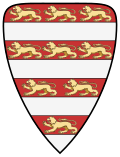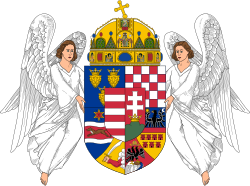Quốc huy Hungary
From Wikipedia, the free encyclopedia
Remove ads
Quốc huy Hungary hiện tại được ban hành vào tháng 7 năm 1990, sau khi chế độ xã hội chủ nghĩa tại Hungary sụp đổ. Phần phía trên của quốc huy là vương miện Thần thánh Hungary với cây thánh giá bị nghiêng. Vương miện này được gửi đến từ thành La Mã cho vị vua đầu tiên trong lịch sử Hungary: vua István I lên ngôi năm 1000. Bốn đường kẻ ngang màu bạc tượng trưng cho bốn con sống chính ở Hungary.
Remove ads
Lịch sử
Danh sách quốc huy của Hungary
Thời kỳ quân chủ
 |
Xuất hiện vào triều đại của Quốc vương Béla III của Hungary (1172–1196).[3][4] |
 |
Các sọc đỏ và trắng là biểu tượng huy hiệu của triều đại Árpád, lần đầu tiên xuất hiện vào năm 1202, trong huy hiệu của con dấu của Vua Emeric (trị vì 1196–1204).[3]
Đây là huy hiệu của Emeric được sử dụng trên Con Bò Vàng năm 1202 của ông. Nó cho thấy chín con sư tử.[5] |
 |
Trên Con Bò Vàng năm 1222, do András II (trị vì 1205–1235) ban hành, các sọc có bảy con sư tử.[6] Sư tử là một biểu tượng phổ biến của quyền lực hoàng gia.[3] |
 |
Huy hiệu của Stephen V (trị vì 1270–1272) là một hình tam giác màu đỏ cong ở tất cả các cạnh được viền bởi các đường màu bạc và đen. Ở phía dưới có một ngọn núi ba đỉnh màu xanh lá cây trên nền đỏ, từ đó một chữ thập kép màu bạc vươn lên. Ở phần dưới của nó, có một vòng hoa màu xanh lá cây.[7] |
 |
Huy hiệu của Vua Ladislaus IV của Hungary (1272–1290) |
 |
András III (trị vì 1290–1301) sử dụng một chiếc khiên hình tam giác màu đỏ có cạnh cong và khung màu bạc và đen làm huy hiệu của mình. Ở giữa nó có hình chữ thập kép thông thường màu bạc, nhưng có vòng hoa màu xanh lá cây quanh phần dưới và đáy nhọn. Ở phía trên bên trái có hình lưỡi liềm màu bạc, trong khi ở bên phải là hình ngôi sao sáu cánh màu bạc.[8] |
 |
Con dấu của Wenceslaus III (trị vì 1301–1305 ) cho thấy chữ thập kép đơn giản với ba ngọn núi màu xanh lá cây. Sau khi nhánh nam của triều đại Árpád tuyệt chủng vào năm 1301, những người претендент lên ngôi từ nhánh nữ của triều đại đã sử dụng chữ thập kép để biểu thị yêu sách của họ đối với danh hiệu hoàng gia Hungary.[3] |
 |
Khi dòng họ Árpád tuyệt diệt và dòng họ Angevin lên nắm quyền, họ muốn nhấn mạnh tính hợp pháp và mối quan hệ mẫu hệ của mình với dòng dõi hoàng gia trước đó bằng cách sử dụng huy hiệu của dòng họ Árpád, với các sọc đỏ và trắng. Károly I đã kết hợp huy hiệu này với biểu tượng hoa bách hợp của dòng họ Angevin. |
 |
Huy hiệu của vua Lajos I |
 |
Đại huy hiệu của Vua Mátyás. Ở giữa là huy hiệu cá nhân của Mátyás Corvin (chia làm bốn phần: 1. Chữ thập hai thanh của Hungary, 2. Triều đại Árpád, 3. Bohemia, và 4. Gia tộc Hunyadi) và huy hiệu của vợ ông, Beatrice của Naples (chia làm bốn phần: 1. và 4. Triều đại Árpád – Pháp cổ đại – Jerusalem bị đóng đinh; 2. và 3. Aragon), phía trên là vương miện hoàng gia. Ở rìa ngoài có huy hiệu của nhiều vùng đất khác nhau, bắt đầu từ trên xuống theo chiều kim đồng hồ là: Bohemia, Luxembourg, Hạ Lusatia, Moravia, Áo, Galicia–Volhynia, Silesia, Dalmatia-Croatia, hạt Beszterce. |
 |
Lajos I của Hungary đã kết hợp các sọc đỏ và trắng của dòng họ Árpád với chữ thập kép trên đỉnh hình tam giác. Thiết kế này cũng được János Zápolya sử dụng, với huy hiệu gia tộc của ông trong một tấm khiên nhỏ bên trong. |
 |
Hai huy hiệu thường được thể hiện cạnh nhau trong thế kỷ 15. Sự kết hợp của chúng theo kiểu chia đôi, với các sọc ở bên phải và chữ thập có ba đỉnh ở bên trái, lần đầu tiên xuất hiện trên tiền xu trong thời trị vì của Vladislaus I (1440–1444),[cần dẫn nguồn] và sau đó trên tiền xu của Mátyás Corvin (1458–1490). Vương miện phía trên huy hiệu cũng xuất hiện trong thời trị vì của Vladislaus I. Ban đầu nó chỉ là một vương miện không xác định, nhưng trên con dấu năm 1464 của Mátyás Corvin, nó giống với Vương miện Thánh của Hungary hơn.
Phiên bản hiện đại của huy hiệu gia tộc được phát triển trong thời kỳ trị vì của Matthias II vào đầu thế kỷ 17. Việc sử dụng nó trở nên phổ biến trong thời kỳ trị vì của Maria Theresa. |
 |
Trong cuộc Cách mạng Hungary năm 1848, sau khi triều đại Habsburg bị phế truất vào ngày 14 tháng 4 năm 1849, vương miện thiêng đã bị loại bỏ khỏi quốc huy. Tiểu quốc huy còn lại thường được gọi là "Quốc huy Kossuth" (tiếng Hungary: Kossuth-címer) theo tên Lajos Kossuth, Tổng thống nhiếp chính của Hungary (vì vậy, trái với tên gọi, đây không phải là quốc huy của gia tộc Kossuth). Tuy nhiên, trong quốc huy lớn, vòng nguyệt quế đã thay thế vương miện cả ở phần trung tâm và phía trên tấm khiên, như trong hình ảnh bên cạnh. |
 |
Trong những thế kỷ tiếp theo, quốc huy của Hungary ngày càng trở nên phức tạp hơn. Nó bao gồm quốc huy của các vùng lãnh thổ thuộc Vương miện Thánh Stephen: Croatia, Dalmatia, Slavonia,[9] và Bosnia, nhưng cái gọi là "tiểu quốc huy" luôn là phần trung tâm. (Những quốc huy phức tạp hơn được gọi là "quốc huy trung bình" và "quốc huy lớn".) Hình ảnh bên cạnh cho thấy quốc huy trung bình, được sử dụng chính thức (với một số sửa đổi) từ Thỏa hiệp Áo-Hung năm 1867 cho đến khi kết thúc Chiến tranh thế giới thứ nhất(1918). Các phần bên ngoài (ngược chiều kim đồng hồ từ trên cùng bên trái) là quốc huy của Dalmatia, Slavonia, Bosnia (được thêm vào năm 1915), Fiume, Transylvania và Croatia.
Khi Hungary trở thành một phần của chế độ quân chủ Habsburg, quốc huy cũng trở thành một phần của quốc huy, nhưng sau đó tầm quan trọng của nó giảm dần và trong thời kỳ trị vì của Joseph II – người thậm chí không được đội vương miện Thánh – quốc huy đã bị loại bỏ khỏi tiền xu. |
 |
Được sử dụng từ năm 1915 đến năm 1918. Sau khi cuộc cách mạng bị đàn áp, quốc huy Hungary không được sử dụng lại cho đến Thỏa hiệp Áo-Hung năm 1867, khi tiểu quốc huy có vương miện một lần nữa trở thành một phần của quốc huy phức tạp hơn, tương tự như quốc huy cỡ trung bình được hiển thị ở trên. Quốc huy Hungary cũng trở thành một phần của quốc huy chung của Áo-Hung . |
Từ thế kỷ 20
 |
Sau Chiến tranh thế giới thứ nhất, Đệ Nhất Cộng hòa Hungary ban hành quốc huy mới, gần như giống với "tiểu quốc huy" cũ nhưng loại bỏ các yếu tố quân chủ. |
 |
Năm 1919, Cộng hòa Hội đồng Hungary đã hoàn toàn bãi bỏ quốc huy truyền thống và sử dụng ngôi sao đỏ năm cánh của chế độ cộng sản trên các văn bản chính thức. Sau khi chế độ cộng sản sụp đổ, quốc huy Kossuth được sử dụng trong một thời gian ngắn. |
 |
Sau khi vương quốc được khôi phục, tiểu quốc huy (với vương miện thánh và hai thiên thần) đã trở thành huy hiệu chính thức cho đến khi Hiệp ước Vienna lần thứ nhất năm 1938 được ký kết, khi chính phủ bắt đầu sử dụng lại huy hiệu năm 1915 một cách chính thức. |
 |
Trong thời kỳ Đức Quốc xã chiếm đóng Hungary năm 1944–1945 vào cuối Thế chiến II, chính phủ bù nhìn do Đảng Mũi tên Chữ thập phát xít[10] thành lập đã thêm chữ "H" (viết tắt của Hungaria) và biểu tượng Mũi tên Chữ thập vào đó. |
 |
Sau khi quân đội Đức Quốc xã bị Hồng quân đánh bại tại Hungary, Liên Xô đã chiếm đóng Hungary, dẫn đến việc thành lập chính phủ cộng sản ở nước này. Từ năm 1946 đến năm 1949, quốc huy kiểu Kossuth được sử dụng, sau đó Cộng hòa Nhân dân Hungary đã giới thiệu quốc huy mới phù hợp với huy hiệu xã hội chủ nghĩa, với bố cục gần giống với quốc huy của Liên Xô. |
 |
Trong cuộc cách mạng năm 1956, huy hiệu "Kossuth" lại được sử dụng. Trong các bản tin thời sự cũ, huy hiệu Kossuth có thể được nhìn thấy vẽ trên tháp pháo của nhiều xe tăng cách mạng chiến đấu chống lại cuộc xâm lược của Liên Xô trên đường phố Budapest.[cần dẫn nguồn] Mặc dù cuộc cách mạng này nhanh chóng bị quân đội Liên Xô đàn áp, chính phủ Cộng sản mới đã không khôi phục lại quốc huy năm 1949–1956, và do đó huy hiệu này đã được sử dụng trong khoảng một năm. |
 |
Một quốc huy mới được tạo ra vào cuối năm 1957, kết hợp một tấm khiên truyền thống hơn (mang cờ tam tài đỏ-trắng-xanh lá cây của Hungary) vào trong vòng nguyệt quế và ngôi sao đỏ của huy hiệu xã hội chủ nghĩa. Việc sử dụng quốc huy này chấm dứt với việc thông qua quốc huy hiện tại vào năm 1990. |
 |
Từ năm 1990, tiểu quốc huy với vương miện là quốc huy của Hungary. Quốc hội dân chủ đầu tiên tranh luận về việc giữ hay bỏ Vương miện trong quốc huy. Liên minh Dân chủ Tự do thuộc phe đối lập đề xuất sử dụng phiên bản kiểu Kossuth không có Vương miện, nhưng Chính phủ quyết định sử dụng quốc huy của chế độ quân chủ.[11] |
Remove ads
Xem thêm
Tham khảo
Liên kết ngoài
Wikiwand - on
Seamless Wikipedia browsing. On steroids.
Remove ads



